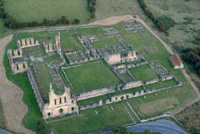 |
 |
 |
 |
 |
 |
 |
|
Byland Abbey: History
Byland Abbey: Buildings
|
Introduction Byland was founded as a Savigniac house in 1134, but was brought within the Cistercian family in 1147, when Savigny and her affiliations were absorbed by the Cistercian Order. The community had a rather unsettled start and the monks moved five times before they eventually established a thriving monastery at the present site of New Byland, near Coxwold. Byland’s early history was marked by disputes with Furness and Calder regarding its independence, and with its neighbouring houses at Rievaulx and Newburgh. The monks overcame these hardships and by the late twelfth century Byland’s reputation was such that it was described by a Yorkshire Augustinian as one of the ‘three shining lights of the North’.(1) Although Byland did not have achieve the celebrity or financial success of its neighbour, Rievaulx, the monastery was renowned for sheep-rearing and the export of wool, and its twelfth-century church was amongst the most impressive in Cistercian Europe. The community experienced mixed fortunes throughout the Middle Ages. Some of the monks’ misfortunes were of their own making, others were caused by external factors including war, famine and plague. At the time of the Dissolution Byland was valued at £238 9s 4d and, according to the duke of Norfolk, exercised more hospitality than any other house in the region.(2) The monastic ruins at Byland are of considerable importance today. Of particular interest are thirteenth-century floor tiles in the abbey church and an altar table, which is now in Ampleforth. A stone lectern base recovered from the chapter-house is the only surviving example of its kind in England. |
